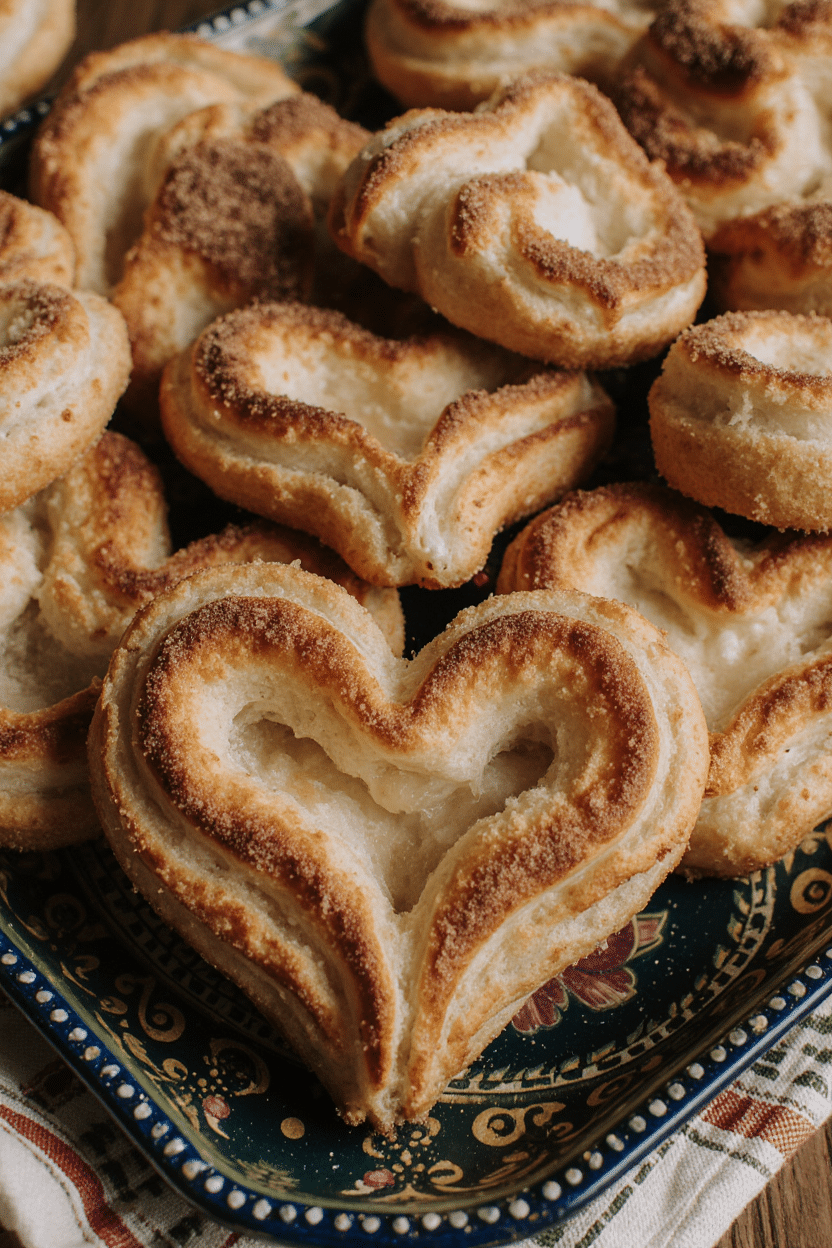Flaky, buttery, and lightly caramelized with cinnamon sugar, Orejas—or Orejitas—are a beloved Mexican pan dulce that captures the nostalgic essence of a traditional bakery. Shaped like ears, hearts, or butterfly wings, these puff pastry cookies are both visually delightful and addictively crispy.
Perfect with a hot cup of café de olla or Mexican hot chocolate, these treats are incredibly simple to prepare with just three basic ingredients. Whether you’re planning a brunch table or a cozy afternoon snack, Orejas bring comfort, warmth, and a hint of sweetness to every bite.
Full Recipe:
-
2 sheets puff pastry (thawed if frozen)
-
1 cup granulated sugar
-
2 teaspoons ground cinnamon
-
Optional: 2 tablespoons melted butter (for extra caramelization)
Directions:
-
Preheat oven to 375°F (190°C). Line a baking sheet with parchment paper.
-
In a small bowl, combine sugar and cinnamon.
-
Place a sheet of puff pastry on your countertop (no need to flour it). Lightly roll to flatten.
-
Sprinkle generously with cinnamon-sugar. Use the rolling pin to gently press the sugar into the dough.
-
Fold the right and left edges of the puff pastry inward about 1 inch. Repeat folding toward the center until the two sides meet in the middle.
-
If desired, lightly brush with melted butter for added richness.
-
Slice the folded pastry into ¾-inch pieces. Optionally dip each side into extra cinnamon-sugar.
-
Arrange cookies on prepared baking sheet, spacing well apart.
-
Repeat the same with the second sheet of puff pastry.
-
Bake for 20 minutes. Flip each piece and bake for another 4–5 minutes until crisp and golden.
Prep Time: 10 minutes | Cooking Time: 25 minutes | Total Time: 35 minutes
Kcal: 130 kcal | Servings: 18 cookies
Recipe Overview
If you’ve ever wandered into a Mexican panadería, chances are you’ve seen those golden, heart-shaped pastries glistening under glass—light, flaky, and generously dusted in cinnamon sugar. These are Orejas, or Orejitas, which charmingly translates to “little ears.” Known elsewhere as palmiers or elephant ears, these cookies are delightfully crisp, sweet, and buttery, made with just a few simple ingredients—puff pastry, sugar, and cinnamon—but delivering on big flavor and nostalgic comfort.
They’re the kind of treat that makes you pause mid-bite, bringing to mind cozy mornings, bustling neighborhood bakeries, and the warm scent of cinnamon that seems to whisper, “home.” Best of all? They’re incredibly easy to make and infinitely enjoyable to eat, whether paired with a cup of café de olla, a mug of hot chocolate, or just enjoyed on their own.
History and Origin
The origin of Orejas is an excellent example of cultural crossover through food. While the pastry technique itself—laminated dough rolled into a scroll—is French in origin, where it’s known as palmiers (meaning “palm leaves”), this beloved treat found a new identity in Latin America, especially Mexico. The French influence on Mexican cuisine dates back to the 19th century, during and after the French occupation of Mexico (1861–1867). As with many foods, the Mexican version evolved to embrace local flavors and traditions.
In France, palmiers are typically more neutral in flavor or lightly sugared. But in Mexico, they got a cozy makeover—crispy edges caramelized with cinnamon-sugar and often extra crispy to satisfy that panadería crunch we know and love. Over time, these pastries became staples at local bakeries and festive gatherings, often nestled beside conchas, cuernitos, and empanadas de fruta. They’ve become a sweet symbol of Mexican home baking and a delightful indulgence that transcends generations.
Variations and Adaptations
While the classic version of Orejas calls for just puff pastry and cinnamon sugar, there are plenty of delicious riffs on the original depending on region, occasion, or personal taste.
-
Chocolate-Dipped Orejas: After baking, half the cookie is dipped in melted dark or milk chocolate and cooled until set.
-
Glazed Orejas: Some panaderías add a light sugar glaze or honey drizzle on top for added sweetness and shine.
-
Spiced Orejas: In some homes, cinnamon is combined with a pinch of clove or nutmeg for a more complex flavor profile.
-
Savory Adaptations: Though less common, puff pastry can be used for savory versions, using herbs, cheese, or even pesto instead of sugar.
-
Latin American Variations: In countries like Argentina and Colombia, you might find these pastries in slightly different shapes, often without cinnamon but still with a sugar crust.
Whether sticking to tradition or branching out with your own twist, the base recipe remains endlessly versatile and forgiving—perfect for beginner bakers and seasoned pros alike.
Nutritional Information
While Orejas are definitely a treat, understanding their nutritional value can help you make more mindful choices. Each cookie (approximately 1 medium-sized oreja) contains about:
-
Calories: 120–150 kcal
-
Fat: 7–9g (mostly from butter in the puff pastry)
-
Carbohydrates: 14–18g (primarily from sugar and pastry)
-
Sugar: 6–9g
-
Protein: 1–2g
Puff pastry is high in fat due to its laminated layers of dough and butter (or sometimes shortening), which gives the cookie its signature flake. The sugar coating adds to the caloric and carb count, but also delivers that irresistible crunch and sweetness.
Micronutrient-wise, these pastries don’t provide much in the way of vitamins or minerals. However, if you make them using a high-quality butter puff pastry (like one made with grass-fed butter), you may get small amounts of vitamin A and omega-3 fatty acids.
Serving Suggestions and Pairings
Orejas shine brightest as a mid-morning or late-afternoon treat, ideally accompanied by something warm and comforting. They’re perfect with:
-
Café de olla: The traditional Mexican coffee brewed with cinnamon and piloncillo.
-
Mexican hot chocolate: Especially the thick, spiced version made with disks of chocolate Abuelita.
-
Atole or champurrado: These masa-based drinks balance beautifully with the pastry’s light crunch.
-
Dessert boards: Include Orejas alongside fruit, dark chocolate, and other pan dulces for a festive dessert grazing table.
-
Holiday brunches: Arrange them in a circle for a “pastry wreath” effect that guests can pull apart.
And if you’re feeling extra decadent? Serve them warm with a scoop of vanilla ice cream or a drizzle of cajeta (Mexican goat’s milk caramel).
Tips and Tricks for Success
Even though Orejas are relatively simple to prepare, a few expert tips can take them from good to panadería-perfect:
-
Chill your dough: If puff pastry gets too warm, the butter melts prematurely, and you lose that flaky lift. Work quickly and chill the dough between steps if needed.
-
Don’t skimp on sugar: The cinnamon-sugar coating is what caramelizes and creates that golden crust. Be generous.
-
Use parchment paper: These cookies can get sticky from the caramelized sugar. Parchment helps avoid stuck bottoms and burnt edges.
-
Flip halfway: For even browning on both sides, carefully flip the cookies midway through baking.
-
Spacing matters: Give them room to expand on the baking sheet—these cookies puff up and spread out.
Potential Health Benefits
While Orejas are more about indulgence than health food, a few ingredients do have redeeming qualities:
Advertisement
-
Cinnamon: This spice has been linked to anti-inflammatory and antioxidant benefits. It may help with blood sugar regulation, though the sugar in the cookie likely offsets that.
-
Butter (if used over shortening): Grass-fed butter contains healthy fats, including conjugated linoleic acid (CLA), which may have anti-inflammatory properties.
-
Mental wellness: Let’s not discount the emotional benefits—there’s something incredibly comforting and joyful about a familiar sweet baked from scratch.
As with all treats, moderation is key. And making them at home means you control the ingredients—opt for all-butter puff pastry, organic sugar, or alternative sweeteners if you’d like a slightly better-for-you version.
Conclusion
Orejas are more than just a pretty cookie—they’re a bridge between cultures, a nostalgic nod to childhood, and an example of how simple ingredients can become something special. Whether you’re recreating memories from your favorite bakery or introducing your family to a new tradition, these crispy, cinnamon-sugar treats are guaranteed to bring smiles.
So roll out that puff pastry, turn on some music, and let the scent of cinnamon fill your kitchen. Because sometimes, the simplest things—like a little “ear” of puff pastry—are the ones that speak loudest to the heart.





